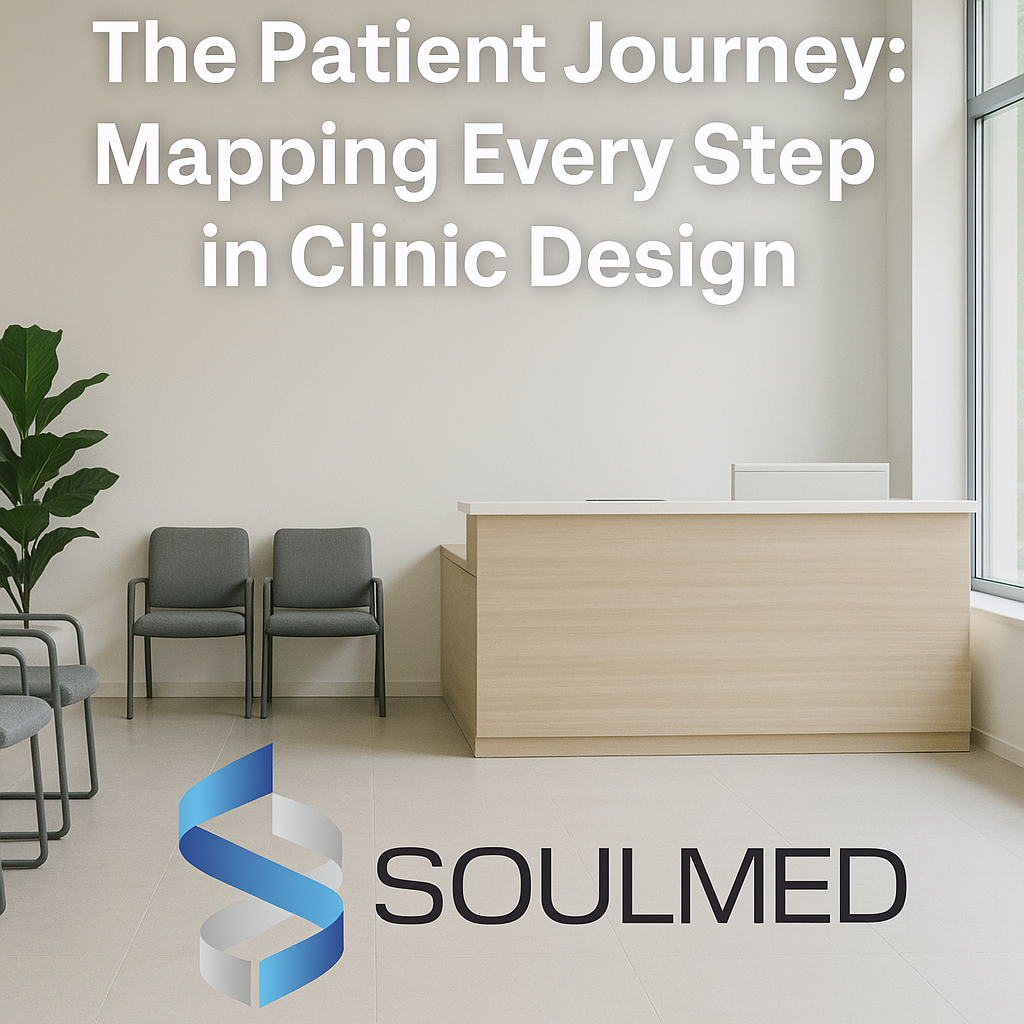Introduction: Why Patient Flow Matters
In healthcare design, the patient journey is more than just a series of physical steps. It’s the emotional and functional experience patients encounter from the moment they arrive until they leave the clinic. At SoulMed, we carefully map this journey to ensure every touchpoint – entry, waiting, consultation, treatment, and exit – is smooth, welcoming, and stress-free.
By eliminating bottlenecks and improving flow, we not only create a better patient experience but also enhance staff efficiency and clinic profitability. This approach aligns with the principles of patient-centred care promoted by the Australian Commission on Safety and Quality in Health Care.
Step 1: Entry – First Impressions That Matter
The entrance sets the tone for the patient’s entire visit. A cluttered, confusing entry creates anxiety before the appointment even begins. SoulMed focuses on:
- Clear wayfinding: Visible signage and intuitive layouts guide patients effortlessly from the front door to reception.
- Welcoming reception areas: Warm lighting, natural finishes, and comfortable furniture immediately put patients at ease.
- Accessibility: Wide doors, ramps, and compliant layouts ensure every patient, including those with mobility needs, feels included.
For further guidance on accessibility, see the Disability Discrimination Act (DDA) and Premises Standards from the Australian Human Rights Commission.
Step 2: Waiting – Comfort Without Congestion
Waiting is often the most stressful part of a medical visit. SoulMed designs waiting spaces to reduce this stress while maintaining operational efficiency:
- Zoned seating: Family-friendly areas, private zones, and quiet corners accommodate different patient needs.
- Real-time updates: Digital displays and integrated queuing systems reduce uncertainty about wait times.
- Ambience: Use of plants, natural light, and acoustic treatments creates a calm, restorative environment.
Evidence shows that well-designed waiting areas can positively impact patient wellbeing (Health Facilities Design Guidelines).
Step 3: Consultation – Privacy and Efficiency
Consultation rooms are the core of the patient journey. Every design choice affects how patients perceive care and how practitioners deliver it. We prioritise:
- Acoustic privacy: Walls and doors designed to prevent conversations from being overheard.
- Workflow alignment: Equipment placement and furniture layouts that allow practitioners to work without unnecessary movement.
- Patient comfort: Adequate space for family members, ergonomic chairs, and soothing colour palettes.
Privacy in healthcare is also reinforced by the Privacy Act 1988 and the Australian Privacy Principles.
Step 4: Treatment – Safety and Accessibility
In treatment areas such as radiology suites, dental chairs, or procedure rooms, safety and accessibility are critical. SoulMed ensures:
- Compliance with regulations: From lead shielding in radiology rooms to fire safety and waterproofing, compliance is embedded in design as per the National Construction Code (NCC).
- Smooth transitions: Logical positioning of treatment rooms near consultation areas minimises patient movement and confusion.
- Stress reduction: Lighting, ventilation, and finishes are selected to reduce clinical anxiety and improve patient comfort.
Step 5: Exit – A Lasting Impression
The journey doesn’t end at treatment. A clear, well-designed exit experience leaves patients feeling cared for and confident about returning. Key considerations include:
- Discrete billing areas: Private, easy-to-access checkout spaces reduce congestion at reception.
- Simple navigation: Clear pathways guide patients back to the exit without confusion.
- Positive reinforcement: Signage or visual cues that reassure patients of the clinic’s commitment to their wellbeing.
Beyond Flow: The Emotional Journey
While mapping patient flow is about logistics, at SoulMed we also consider the emotional journey. Every design element – colour schemes, artwork, furniture selection, even the acoustics – contributes to how patients feel.
Studies in healthcare design demonstrate that environments with natural light, calming colours, and biophilic elements improve both patient and staff outcomes (The Centre for Health Design).
Conclusion: Designing with Patients in Mind
At SoulMed, mapping the patient journey is central to our design philosophy. By aligning every stage – entry, waiting, consultation, treatment, and exit – we create clinics that are efficient, compliant, and above all, patient-centred. The result is a space where patients feel comfortable, practitioners can perform at their best, and the clinic thrives operationally.
If you’re planning a new clinic, relocation, or renovation, let’s map your patient journey together – and design a healthcare space that works for everyone.

